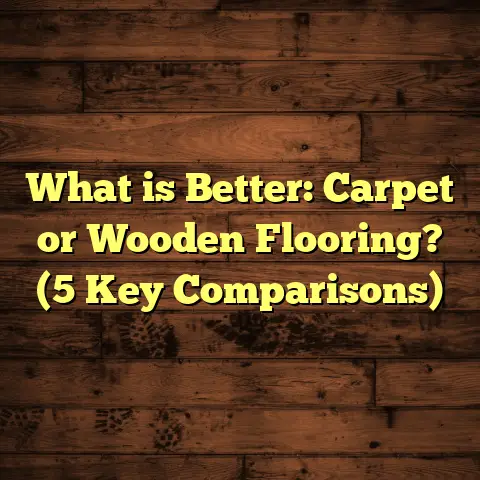What is Marble Flooring? (5 Benefits You Need to Know!)
Marble flooring has this incredible quality that makes it feel like it’s been around forever. When I first stepped into a home with marble floors, I was struck by its timeless elegance. It doesn’t matter if the design is classic or modern; marble somehow fits right in. That’s the beauty of it—it’s a material that carries history and luxury all at once.
The more time I spend working with marble flooring, the more I appreciate how this natural stone combines durability, beauty, and functionality in a way very few materials do. Over the years, I’ve installed marble floors in various settings—from cozy homes to elegant commercial spaces—and each time I see how it transforms a room.
Today, I want to share everything I’ve learned about marble flooring—what it is, the benefits, some challenges, cost insights, and tips on care and maintenance. Whether you’re considering marble for your next renovation or just curious about the material, I think you’ll find my experiences and data useful.
What Is Marble Flooring?
Let’s start with the basics: what exactly is marble flooring? Simply put, marble flooring is made from slabs of natural stone called marble. Marble forms when limestone undergoes intense heat and pressure deep within the earth, transforming it into a dense rock with a crystalline structure.
This geological process is what gives marble its unique veining and coloration. Unlike synthetic materials or engineered stones, no two pieces of marble are exactly alike. The variations in color and pattern come from mineral impurities and the way the stone was formed millions of years ago.
When we use marble as flooring, large slabs or tiles are cut from these raw blocks and polished to a smooth finish. The polishing not only enhances the stone’s natural veining but also creates that luxurious glossy surface that marble is famous for.
Marble comes in many varieties depending on where it’s quarried. Some of the most popular types include:
- Carrara Marble: Hailing from Italy, Carrara is known for its subtle gray veins on a white or light blue background.
- Calacatta Marble: Also Italian but rarer than Carrara, Calacatta has bolder and more dramatic veins with a whiter background.
- Statuario Marble: Another prized Italian marble with striking veining patterns.
- Crema Marfil: A warmer beige marble from Spain often used in Mediterranean designs.
- Emperador Marble: A darker marble with rich brown tones and light veins.
Each type has its own personality and suits different styles and preferences.
What Sets Marble Apart From Other Stones?
You might wonder how marble compares to other natural stones like granite or travertine. Granite is generally harder and more resistant to scratching but lacks the same level of translucency and softness that gives marble its signature glow. Travertine has a porous texture with natural pits and holes that give it an earthy look but requires more maintenance due to its porosity.
Marble strikes a balance between beauty and strength. It’s softer than granite but hard enough for flooring purposes and can be polished to a mirror-like finish that’s hard to beat.
Why I Recommend Marble Flooring: 5 Benefits You Need to Know
After working with marble floors on numerous projects, I’ve seen firsthand how it stands out among flooring options. Here are five key benefits you should know.
1. Timeless Beauty That Never Fades
Marble floors have been around for thousands of years—ancient Roman villas, Renaissance palaces, and modern luxury homes all feature them. This speaks volumes about their timeless appeal.
I recall walking through a historical mansion where the original marble flooring had survived centuries of wear. Despite some fading and minor chips, the floor still radiated sophistication. It felt like stepping into history without sacrificing style.
What’s fascinating is how versatile marble can be in design. Whether your style is ultra-modern minimalism or classic elegance, there’s a type of marble and finish that fits perfectly.
If you want something bright and airy, Carrara marble with its subtle veins works beautifully. For bolder statements, Calacatta or Statuario marbles offer dramatic contrasts. Even colored varieties like green or black marbles add an exotic touch.
Understanding Marble’s Natural Veining
Marble’s veining patterns are created by mineral deposits like iron oxides or graphite during its formation. These veins can be thin lines or broad streaks behaving almost like fingerprints—each slab tells its own story.
This uniqueness means every floor is one of a kind, which adds character to your home or space. While some people worry about matching veins during installation, skilled installers can create beautiful layouts that highlight marble’s natural beauty.
Data Point:
A survey by Houzz found that 18% of homeowners who upgraded their floors chose natural stone—marble was among the top choices for those seeking luxury finishes.
2. Durability That Lasts Generations
Marble isn’t just about good looks; it’s built to last. Marble has a Mohs hardness rating between 3-5, which means it’s robust enough for residential and light commercial use.
I’ve seen marble floors withstand heavy foot traffic in commercial lobbies without losing their shine. Of course, it’s softer than granite but harder than many other stones used for flooring.
One project I worked on involved restoring worn-out marble in a busy hotel lobby. After professional polishing and resealing, the floor looked brand new again—proof that proper maintenance can extend marble’s life significantly.
How Long Does Marble Flooring Last?
Marble can last decades or even centuries with proper care. According to the Natural Stone Institute, well-maintained marble flooring in residential homes can easily last more than 75 years. Some historical buildings have original marble floors that are over 500 years old!
What About Scratches and Chips?
While durable, marble can scratch or chip under heavy impact or dragged furniture. I always recommend using protective pads under furniture legs and avoid dropping heavy objects.
Sealing helps protect against stains but doesn’t prevent physical damage. The good news is minor scratches can often be buffed out by professionals.
3. Adds Significant Value to Your Home
If you’re thinking about resale value—marble flooring can be a major selling point.
When I worked on a home renovation recently, upgrading the kitchen and entryway floors to marble increased the property value noticeably. The buyers appreciated the premium look and were willing to pay more for it.
Real estate data supports this too—homes with natural stone floors often see up to a 15% increase in resale value compared to those with standard flooring materials.
Why Does Marble Add Value?
Marble signifies quality craftsmanship and luxury—traits buyers associate with well-built homes. It also suggests longevity and easy maintenance compared to carpet or laminate floors that may need replacement sooner.
4. Naturally Cool Surface Ideal for Warm Climates
If you live in a warm area like I do sometimes during summer months, you’ll love this benefit of marble flooring—it stays cool underfoot!
Unlike wood or carpet, marble absorbs heat slowly due to its thermal conductivity properties. This means walking barefoot on marble floors feels refreshing even on hot days.
In Mediterranean countries, where summers get scorching hot, marble floors are a traditional choice precisely because they help keep interiors cool naturally without relying heavily on air conditioning.
My Experience With Marble in Warm Climates
I installed marble floors in a beach house located in Florida where temperatures rise above 90°F regularly. The homeowners told me they noticed an immediate difference in comfort compared to their previous carpeted floors.
Data shows that natural stone floors like marble have thermal conductivity rates between 1.5 – 3 W/mK (watts per meter kelvin), which means they conduct heat away from your feet faster than wood or vinyl floors.
5. Easy Cleaning and Maintenance Routine
One thing many clients appreciate about marble is how simple it is to clean daily. A quick sweep or vacuum followed by mopping with warm water keeps it looking fresh.
Unlike carpets that trap dust and allergens, smooth marble surfaces don’t hold dirt easily—making it ideal for people sensitive to allergies.
Of course, spills should be wiped quickly because acidic substances such as lemon juice or vinegar can etch the surface if left too long. But with routine sealing every 12-24 months using high-quality sealants, stains are minimized.
How To Maintain Marble Flooring Properly
- Sweep or dust mop frequently to avoid grit buildup.
- Clean spills immediately.
- Use pH-neutral cleaners specifically designed for stone.
- Avoid harsh chemicals like bleach or ammonia.
- Schedule professional polishing every few years if needed.
- Seal the surface regularly based on wear level.
From my experience, clients who follow these simple steps find their floors stay beautiful for decades without costly repairs.
Addressing Common Concerns About Marble Floors
While I’m enthusiastic about marble flooring, there are some concerns homeowners often raise before deciding:
Is Marble Slippery?
Yes, polished marble can be slippery when wet. In homes with kids or elderly residents, this might pose risks.
To reduce slipperiness:
- Choose honed (matte) finishes instead of polished.
- Use area rugs or mats in high-risk spots.
- Apply anti-slip treatments available from flooring professionals.
Does Marble Stain Easily?
Marble is porous so some liquids like red wine or oil can stain if not cleaned quickly. Sealing helps prevent deep absorption but regular maintenance is key to avoid permanent stains.
How Expensive Is Marble Flooring?
Costs vary widely depending on marble type, tile size, installation complexity, and location.
On average:
- Material costs range from $5 to $20 per square foot.
- Installation adds $5 to $15 per square foot.
For example, installing Carrara marble might cost $15-$25/sq ft total, while rare Calacatta could reach $30/sq ft or more.
I usually use FloorTally when planning projects because it helps me estimate costs accurately based on local prices for materials and labor. This tool factors in waste percentages too so budgets are realistic without surprises.
Case Study: My Recent Marble Flooring Project
Let me share one standout project that really highlighted marble’s benefits for me.
I was hired by a couple renovating their mid-century home who wanted a high-end look without losing warmth and personality. We settled on white Carrara marble with subtle gray veins for living areas and kitchen.
Using FloorTally gave us clear budget expectations upfront: $22 per square foot installed including sealing and trim work.
The installation took about two weeks due to careful layout planning to line up veining patterns beautifully across rooms. After finishing touches like polishing and sealing, the homeowners were thrilled with how bright and spacious their home felt.
They especially loved how easy cleaning was compared to their old carpeted floors. Over six months follow-up calls confirmed no issues with wear or staining despite having two kids running around daily.
How Marble Flooring Compares To Other Popular Flooring Types
If you’re unsure whether marble suits your needs better than other options like hardwood or tile, here’s a quick comparison based on my experience:
| Feature | Marble | Hardwood | Porcelain Tile | Vinyl |
|---|---|---|---|---|
| Appearance | Luxurious natural veining | Warm wood grain | Wide variety of finishes | Affordable mimics wood/tile |
| Durability | High (with care) | Moderate (can scratch/dent) | Very high resistance | Moderate |
| Maintenance | Moderate (sealing needed) | Requires refinishing | Low maintenance | Easy |
| Cost (material + install) | $10–$30/sq ft | $6–$12/sq ft | $5–$15/sq ft | $2–$7/sq ft |
| Cooling effect | Naturally cool | Warmer underfoot | Neutral | Neutral |
| Slip resistance | Slippery polished; honed safer | Moderate | Good | Good |
If luxury and longevity are your focus, marble is tough to beat despite higher upfront costs. For budget-conscious projects, vinyl or hardwood might be easier choices but won’t have the same wow factor or lifespan as marble.
Tips For Choosing The Right Marble For Your Floor
Selecting the perfect marble can feel overwhelming with so many options available. Here are my tips based on years of helping clients pick their stone:
- Consider the room lighting: Dark marbles look stunning but might make small rooms feel smaller.
- Match your design style: Warm beige marbles suit traditional interiors; crisp white marbles fit modern spaces.
- Think about foot traffic: Honed finishes handle heavy use better; polished finishes offer more shine but require care.
- Sample before buying: Always see samples in your home lighting before committing.
- Plan for grout color: Grout can affect overall look—light grout for seamless appearance; dark grout highlights tile edges.
How Marble Installation Works: What To Expect
If you decide on marble floors, understanding installation helps prepare you for what lies ahead:
- Preparation: Subfloor must be level and clean.
- Layout planning: Aligning veins and patterns requires skilled craftsmanship.
- Cutting slabs: Large slabs are cut into tiles as per measurements.
- Setting tiles: Adhesive mortar applied; tiles placed carefully.
- Grouting: Spaces between tiles filled after setting.
- Polishing & sealing: Final polishing enhances shine; sealing protects stone.
Installation typically takes longer than laminate or vinyl due to precision required but results are worth the wait for many clients I’ve worked with.
Using Technology To Manage Your Flooring Project
Budgeting and planning large flooring projects can be tricky without proper tools. That’s where something like FloorTally comes in handy from my experience.
It lets me input material choices including specific types of marble along with labor costs based on local rates. It calculates total costs including waste factor (usually 5-10% extra material), so I avoid ordering too little or too much stone.
Plus, it helps compare different material options side-by-side so clients see pros/cons clearly before making decisions.
The interface is easy enough for DIYers but also powerful enough for contractors managing multiple jobs simultaneously—which I found invaluable especially on bigger projects involving custom cuts or intricate layouts.
Caring For Your Marble Floor Over Time
Once installed, keeping your floor looking great requires some ongoing effort but nothing too complicated:
- Dust mop frequently to prevent grit scratching surface.
- Clean spills immediately; avoid acidic cleaners.
- Use felt pads under furniture legs.
- Seal every 1-2 years depending on traffic.
- Consider professional polishing every 3-5 years for best shine restoration.
From my years working hands-on with clients’ homes, those who stick to these simple habits rarely face major issues even after decades of use.
Final Thoughts On Marble Flooring
Marble flooring offers something special—a connection to history combined with modern luxury that few materials can match. Its timeless beauty makes any space feel elegant while its durability means it can last generations if cared for properly.
If you’re considering upgrading your floors soon, why not explore what marble has to offer? With so many types available at varying price points plus tools like FloorTally helping plan costs realistically, choosing marble could be easier than you think.
Have you experienced walking barefoot on cool polished stone? Or maybe you’ve admired an old building’s grand marble entrance? Let me know your thoughts—I’d be glad to share more about how this amazing stone could work in your home too!





